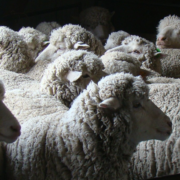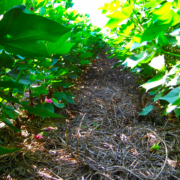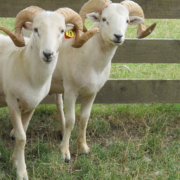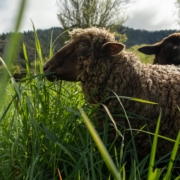Building the Market for Climate-Beneficial Wool
 Print This Post
Print This Post
By Allison Cooley-Agee, NCAT Carbon Farm Planner
In today’s world, fast fashion is everywhere, but we often forget about the journey from soil to fabric. Behind every piece of clothing, there’s a story about soil health and sustainable practices that affect how our clothes are made and their impact on the environment. Let’s explore how wool and cotton fibers are produced and why it matters to all of us.
Imagine standing in a green pasture with sheep grazing peacefully. This is where the story of wool begins. On family ranches, taking care of the soil is crucial for producing high-quality wool. Healthy soil helps retain water, prevent erosion, and support diverse plant life. This creates a better environment for sheep, resulting in superior wool. These ranches not only produce great wool but also create jobs and support local businesses. The journey from soil to sweater shows how sustainable farming can make a significant difference.
Now, let’s look at cotton, a fabric we all know and wear. Some farmers use special practices to take care of the soil while growing cotton. They avoid using excessive chemicals, rotate crops, and plant cover crops to keep the soil healthy. These sustainable practices produce cotton that is not only better in quality but also environmentally friendly. Local fiber systems are being revitalized, supporting rural economies by providing stable employment opportunities. Clothes made from this cotton are compostable and don’t contain harmful microplastics, unlike synthetic fabrics.
Brands and designers play a big role in promoting these sustainable practices. Many are now choosing to source natural fibers from farms that care for their soil. This helps create a transparent and ethical supply chain. As consumers, we have the power to support this movement. By choosing natural fibers over synthetic ones, we can drive demand for sustainable fashion. Natural fibers reduce pollution and are biodegradable, making them a better choice for the planet.
The connection between soil health, fiber production, and the clothes we wear is crucial. Sustainable fashion is more than a trend; it has real benefits for rural economies, the environment, and our health. By choosing natural fibers, we support a system that values sustainability, ethical production, and environmental care. Together, we can create a fashion industry that respects our planet and its people.
Consider the impact of your choices. By choosing natural fibers over synthetics, you support a system that values sustainability and ethical production. Together, we can cultivate a fashion industry that honors the health of our planet and the well-being of its people.
Join the movement towards sustainable fiber production and make conscious choices in your wardrobe. Choose natural fibers and be a part of this positive change.
The Climate Beneficial Fiber Partnership is bringing together farmers, ranchers, and brands to create wool and cotton products that sequester carbon, build soil health, and increase biodiversity on the landscape. You can hear more about our work in our Soil-to-Skin podcast series with Seed2Shirt, New York Textile Lab, and Fibershed.
Related ATTRA Resources:
Episode 355. Soil-to-Skin: Rebecca Burgess of Fibershed on Building Community
Episode 356. Soil-to-Skin: Tameka Peoples of Seed2Shirt Shares Her Journey
Other Resources:
Climate Beneficial Fiber Partnership
This blog is produced by the National Center for Appropriate Technology through the ATTRA Sustainable Agriculture program, under a cooperative agreement with USDA Rural Development. ATTRA.NCAT.ORG.

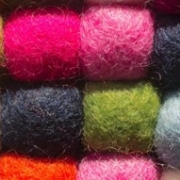
 USDA NRCS
USDA NRCS